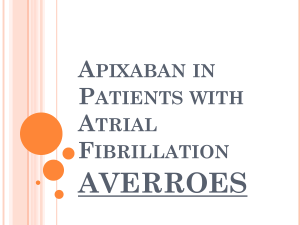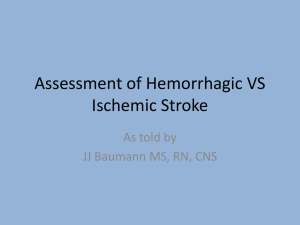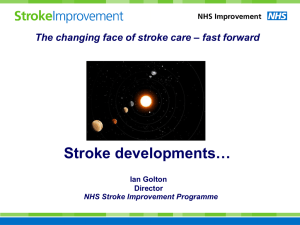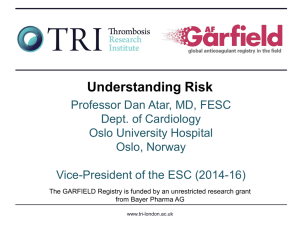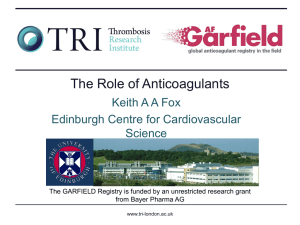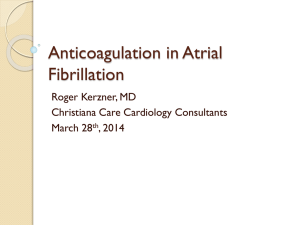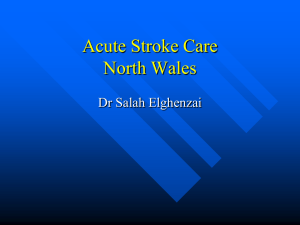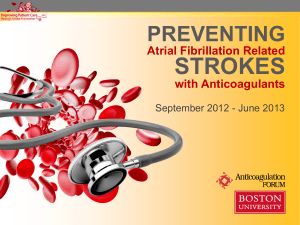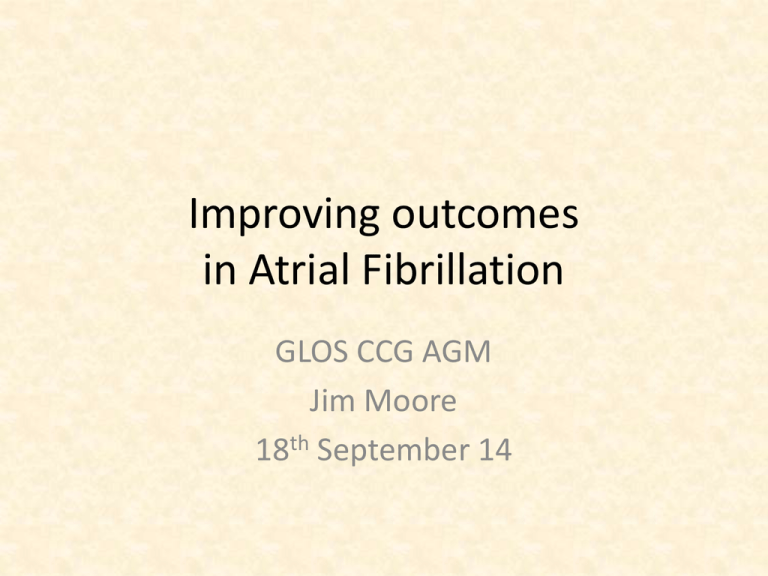
Improving outcomes
in Atrial Fibrillation
GLOS CCG AGM
Jim Moore
18th September 14
=
+
Projected Number of Patients With AF by 2050
Patients with atrial fibrillation (millions)
MarketScan & Thomson Reuters Medicare databases, 2009
16
Olmsted County data, 2006 (assuming a continued
increase in the AF incidence)
14
Olmsted County data, 2006 (assuming no
further increase in the AF incidence)
15.9
15.2
14.3
13.1
11.7
12
ATRIA study data, 2000
10.2
10
11.1
8.9
9.4
6.7
7.5
5.1
5.1
4
2
7.56
8.4
5.9
6
12.1
10.3
7.7
8
11.7
6.8
5.6
6.1
3.03
2.08
2.26
2.44
1995
2000
2005
2.66
2.94
2010
2015
3.33
3.8
4.34
4.78
5.16
5.42
5.61
2040
2045
2050
0
1990
2020
Year
2025
2030
2035
Prevalence AF by practice
3.00%
2.50%
2.00%
1.50%
1.00%
0.50%
0.00%
GP
Practice
s
Prevalence AF a linear
Relationship to over 65yrs
3.0%
Expected prevalence
2.5%
R² = 0.9883
2.0%
1.5%
1.0%
0.5%
0.0%
0.0%
5.0%
10.0%
15.0%
20.0%
25.0%
% practice population >65yrs
30.0%
35.0%
40.0%
Stroke is a serious complication of AF
• AF stroke is usually more severe than stroke due to other
causes1
• Compared with other stroke patients, those with AF are more
likely to:
– Have cortical deficit (e.g. aphasia), severe limb weakness
and diminished alertness, and be bedridden on admission2
– Have longer in-hospital stay with a lower rate of discharge
to their own home3
• The mortality rate for patients with AF is double that in people
with normal heart rhythm4
1. Savelieva I et al. Ann Med 2007;39:371–91; 2. Dulli DA et al. Neuroepidemiology 2003;22:118–23; 3. NICE clinical
guideline 36.June 2006. Available at http://www.nice.org.uk/guidance/CG36/?c=91497; accessed April 2010;
4. Benjamin EJ et al. Circulation 1998;98:946–52
9
Plan
• Personalised package of care
• Identifying patients with AF
• Assessing and managing stroke risk
NICE AF
Key priorities for implementation
• Personalised package of care and
information
• Assessment of stroke and bleeding risks
•
Interventions to prevent stroke
Plan
• Personalised package of care
• Identifying patients with AF
• Assessing and managing stroke risk
Personalised package of care and information
•Offer people with atrial fibrillation a personalised package of care.
Ensure that the package of care is documented and delivered, and that
it covers:
o stroke awareness and measures to prevent stroke
o rate control
o assessment of symptoms for rhythm control
o who to contact for advice if needed
o psychological support if needed
o up-to-date and comprehensive education and information
on: ……………..
Personalised package of care and information (cont)
o Offer people with atrial fibrillation a personalised package of care.
Ensure that the package of care is documented and delivered, and
that it covers:
o up-to-date and comprehensive education and information on:
cause, effects and possible complications of atrial fibrillation
management of rate and rhythm control
anticoagulation
practical advice on anticoagulation
support networks ( e.g. cardiovascular charities)[new2014]
Who are West of England AHSN?
The West of England Academic Health Science
Network is a vibrant and diverse network of
providers of NHS care, universities and NHS
commissioners working with a wide range of parties
to accelerate the spread of innovating evidencebased practice to improve health and care quality
www.weahsn.net
2.4M people
Bath ,Bristol, Swindon
South Gloucestershire, North and North East Somerset,
Gloucestershire, Wiltshire (West & North)
PLAN
• Personalised package of care
• Identifying patients with AF
• Assessing and managing stroke risk
Identifying patients with AF
• Targeted/Opportunistic
-hypertension,
-CVD assessment,
-Diabetes
-Symptoms commonly seen in AF
- when taking blood pressure
• Whole population screening
• Routine clinical practice
SAFE study
Hobbs et al 2005
• A randomised controlled trial and cost-effectiveness study of systematic
screening (targeted and total population screening) versus routine
practice for the detection of atrial fibrillation in people aged 65 and over.
• To determine the most cost-effective method of screening for atrial
fibrillation (AF) in the population aged 65 years and over, as well as its
prevalence and incidence in this age group.
• Fifty primary care centres across the West Midlands, UK.
•
Multi-centred randomised controlled trial. Purposefully selected general
practices were randomly allocated to 25 intervention practices and 25
control practices
• 10,00 patients in intervention practices - 5,000 systematic screening and
5,000 opportunistic screening
• GPs and nurses in intervention practices educated around the
identification of AF and the interpretation of ECGS.
SAFE study results
Hobbs et al 2005
• Baseline prevalence of AF 7.2%
• Incidence of AF/year
-Opportunistic screening 1.64%
-Systematic screening
-Control
1.62%
1.04%
• As far as screening programmes for atrial fibrillation in patients 65 and
over, the only strategy that improved on routine practice was
opportunistic screening
• 60% probability that annual opportunistic screening was cost effective
• The lowest incremental cost was for the opportunistic arm, with an
incremental cost-effectiveness ratio of £337 for each additional case of AF
detected compared to the control arm.
• ECG interpretation - computerised decision support software (CDSS) gave
a sensitivity of 87.3%, a specificity of 99.1% and a positive predictive value
(PPV) of 89.5%
Identification of patients with AF
at Stoke Road Surgery
• Patients presenting with clinical features of AF
• Secondary/Tertiary care diagnosis of AF
• Hypertension monitoring (irregular pulse)
• ECG undertaken for other reasons
Hypertension monitoring
• HCA/PN assessment of radial/ brachial pulse prior
to taking BP(on every occasion) in all patients as
per Hypertension Protocol
• Patients with irregular pulse have 12 lead ECG
undertaken at the same appointment and are
then reviewed by Duty GP
• No BP monitors will accurately measure BP in AF
QOF AF Statistics
(March 14)
Stoke Road Practice
• AF prevalence - 2.6% (see footnote)
National
• AF prevalence range from 1.3 - 1.7%
• Note present SR practice AF prevalence at June 14 = 3.0 %
AGENDA
• Personalised package of care
• Identifying patients with AF
• Assessing and managing stroke risk
Thromboembolic risk assessment is a priority!
………..local guidance
………..international guidance!
When assessing stroke risk ask the
question
…………why should I not anticoagulate
this patient ?
Stroke risk assessment with CHADS2
and CHA2DS2-VASc
Stroke risk assessment with CHADS2
and CHA2DS2-VASc
CHADS score
% AF popltn
0
low risk
16.3
1
moderate risk
26.7
2(+) high risk
57
Cowan C et al. Heart doi:10.1136/heartjnl-2012-303472
Oral anti-coagulation: benefit–risk improves
with increasing age
Net clinical benefit: events prevented per 100 person-years1
2.34
≥85
1.29
1.00
Age, years
75–84
0.44
–0.65
–1
1.40
0.11
–0.37
65–74
<65
3.30
0.40
–0.25
0.08
–0.5
0
Worse with warfarin
Singer DE et al. Ann Intern Med 2009;151:297–305
0.5
1
1.5
2
2.5
Better with warfarin
3
3.5
Coagulation pathway
VII
TF VIIa
VKA
VKA
Initiation
IX
X
Propagatio
n
VKA
Inactive Factor
Xa
IXa
Active Factor
Direct Factor Xa inhibition
II
Rivaroxaban
Direct Factor IIa inhibition
Dabigatran
Prothrombi
n
IIa
Thrombin
Fibrinogen
Fibrin
Spyropoulos AC et al. Expert Opin Investig Drugs 2007;16:431–440 (adapted from)
Transformation
Catalysis
NICE CG180 -Management of AF
Assessment of stroke and bleeding risks
CHA2DS2-VASc stroke risk score should be used to
assess stroke risk in people with any of the
following:
• symptomatic or asymptomatic paroxysmal,
persistent or permanent atrial fibrillation
• atrial flutter
• a continuing risk of arrhythmia recurrence after
cardioversion back to sinus rhythm. [new 2014]
NICE CG180 -Management of AF
Interventions to prevent stroke
• Do not offer stroke prevention therapy to people aged under 65 years
with atrial fibrillation and no risk factors other than their sex (that is,
very low risk of stroke equating to a CHA2DS2-VASc score of 0 for men
or 1 for women). [new 2014]
• Anticoagulation may be with apixaban, dabigatran etexilate,
rivaroxaban or a vitamin K antagonist.
• Consider anticoagulation for men with a CHA2DS2-VASc score of 1.
Take the bleeding risk into account. [new 2014]
• Offer anticoagulation to people with a CHA2DS2-VASc score of 2 or
above, taking bleeding risk into account. [new 2014]
• Discuss the options for anticoagulation with the person and base the
choice on their clinical features and preferences. [new 2014]
… and what harm !
NICE CG180 -Management of AF
Bleeding risk
• Use the HAS-BLED score
to assess the risk of bleeding in people who are starting or have started
anticoagulation. Offer modification and monitoring of the following risk
factors
• uncontrolled hypertension
• poor control of international normalised ratio (INR) ('labile INRs')
• concurrent medication, for example concomitant use of aspirin or a
non-steroidal anti-inflammatory drug (NSAID)
• harmful alcohol consumption. [new 2014]
HAS-BLED should be used to identify modifiable risk factors for bleeding
Score of ≥3 indicates need for regular clinical review
Patients with a higher HAS-BLED score also have a higher CHA2DS2-VASc score
There is net clinical benefit in anticoagulating CHA2DS2-VASc >0 whatever HAS-BLED score
NICE CG180 -Management of AF
Bleeding risk
When discussing the benefits and risks of anticoagulation,
explain to the person that:
• for most people the benefit of anticoagulation outweighs the
bleeding risk
• for people with an increased risk of bleeding the benefit of
anticoagulation may not always outweigh the bleeding risk, and
careful monitoring of bleeding risk is important. [new 2014]
• Do not withhold anticoagulation solely because the person is at
risk of having a fall. [new 2014]
Monitoring anticoagulation control
with Warfarin
Drug and food interactions with
warfarin
VKAs have a narrow therapeutic window
Adjusted odds ratios for ischaemic stroke and intracranial
bleeding in relation to intensity of anticoagulation
Odds ratio for event
20
15
Ischaemic
stroke
10
Intracranial
bleeding
Target
INR
5
1
1.0
2.0
3.0
4.0
5.0
6.0
International normalized ratio
Adapted from Wann et al. Circulation 2011;123;e269-e367
7.0
8.0
Why time in therapeutic range(TTR) matters
NICE CG180 -Management of AF
• Assessing anticoagulation control with vitamin K
antagonists
• Calculate the person's time in therapeutic range (TTR) at each visit.
When calculating TTR:
• use a validated method of measurement such as the Rosendaal
method for computer-assisted dosing or proportion of tests in
range for manual dosing
• exclude measurements taken during the first 6 weeks of treatment
• calculate TTR over a maintenance period of at least 6 months. [new
2014]
NICE CG180 -Management of AF
Assessing anticoagulation control with vitamin K antagonists
• Reassess anticoagulation for a person with poor anticoagulation
control shown by any of the following:
• 2 INR values higher than 5 or 1 INR value higher than 8 within the
past 6 months
• 2 INR values less than 1.5 within the past 6 months
• TTR less than 65%. [new 2014]
NICE CG180 -Management of AF
Assessing anticoagulation control with vitamin K antagonists
When reassessing anticoagulation, take into account and if possible address the
following factors that may contribute to poor anticoagulation control:
• cognitive function
• adherence to prescribed therapy
• Illness
• interacting drug therapy
• lifestyle factors including diet and alcohol consumption. [new 2014]
If poor anticoagulation control cannot be improved, evaluate the risks and
benefits of alternative stroke prevention strategies and discuss these with
the person. [new 2014]
NICE CG180 -Management of AF
Antiplatelets
• Do not offer aspirin monotherapy solely
for stroke prevention to people with atrial
fibrillation. [new 2014]
Management of the patient with AF
1) Thromboprophylaxis
2) Symptom control
3) LV protection
Decreasing
importance
What informs current practice ?
QOF 2014-15
Warfarin reduces the risk of stroke in patients with AF
Warfarin better
Placebo better
AFASAK
SPAF
BAATAF
CAFA
SPINAF
EAFT
RRR = 64%
95% CI: 49 to 74%
All trials
100
50
0
Relative risk reduction (%)*
Error bars = 95% CI;
*Relative risk reduction for all strokes (ischaemic and haemorrhagic)
Hart RG et al. Ann Intern Med 2007;146:857–67
–50
–100
Limited efficacy of aspirin in reducing the risk of stroke
in patients with AF
Aspirin better
Placebo better
AFASAK
SPAF
EAFT
ESPS II
LASAF
125 mg/d
125 mg QOD
UK-TIA
300 mg/d
1200 mg/d
JAST
RRR = 19%
95% CI: –1 to 35%
All trials
100
50
0
Relative risk reduction (%)*
Error bars = 95% CI;
*Relative risk reduction for all strokes (ischaemic and haemorrhagic)
Hart RG et al. Ann Intern Med 2007;146:857–67
–50
–100
Stroke risk and aspirin use
0.9
Percentage of patients
0.8
p<0.001
0.7
0.6
Anti platelets – Male
Anti platelets – Female
p<0.001
Anticoagulants – Male
0.5
0.4
Anticoagulants – Female
p=0.12
0.3
0.2
p=0.57
0.1
0
0
1
2
3
4
5
CHADS2 score
52% of patients diagnosed with AF are treated with antiplatelet treatment such as aspirin
Prescription of aspirin increases steeply with increasing CHADS2 score
Lee S et al. BMJ Open 2011;1:e000269.
Proportion (95% CI) of atrial fibrillation patients prescribed anticoagulant therapy
(A) and antiplatelet therapy (B) by CHADS2 score for patients aged 80 years and
over, and for patients aged under 80 years
Copyright © BMJ Publishing Group Ltd & British Cardiovascular Society. All rights reserved.
Cowan C et al. Heart doi:10.1136/heartjnl-2012-303472
Not all clots are the same
• Thrombi in patients with AF
are predominately fibrin-rich
• Thrombi in coronary artery disease
(CAD) tend to be platelet-rich
• Anticoagulants reduce the
conversion of fibrinogen to fibrin
• Aspirin, and other antiplatelets,
inhibit aggregation of thrombi
caused by CAD but do not
impact upon fibrin production
Lip GYH. Nature Reviews Cardiology 2011:8;602–606
ridge.icu.ac.jp
What the guidelines say about aspirin in
AF-related stroke
Royal College of Physicians, Edinburgh UK Consensus:
March 2012
Aspirin should not be used for stroke prevention in AF
European Society of Cardiology: Management of AF 2012
Aspirin should not be used for stroke prevention in AF
Key message:
Aspirin in
Stroke
Prevention
18.6.14
Oral anticoagulation for stroke prevention in AF
Atrial fibrillation
Yes
Valvular AF*
No (i.e. nonvalvular)
Yes
<65 years and lone AF (including females)
No
Assess risk of stroke CHA2DS2-VASc score
0
1
≥2
Oral anticoagulant therapy
No
antithrombotic
therapy
Assess bleeding risk (HAS-BLED score)
Consider patient values and preferences
Camm AJ, et al. Eur Heart J doi:10.1093/eurheartj/ehs253
NOAC
VKA
Antiplatelet therapy with aspirin plus
clopidogrel or – less effectively – aspirin only,
should be considered in patients who refuse
any OAC or cannot tolerate anticoagulation
for reasons unrelated to bleeding. If there are
contraindications to OAC or antiplatelet
therapy, left atrial appendage occlusion,
closure or excision may be considered
Colour CHA2DS2-VASc: green = 0, blue = 1,
pink ≥2; line: solid = best option;
dashed = alternative option
*Includes rheumatic valvular disease and
prosthetic valves;
NOAC = novel oral anticoagulant;
VKA = vitamin K antagonist
Diagnosis of AF and management of
associated thromboembolic risk in
Primary care
Stoke Road Surgery Bishops Cleeve
Dr Jim Moore GP
Assessment of patients with confirmed AF
by GP
• Admit if evidence of decompensation
• Follow AGWS AF guidelines
• Assess and discuss thromboembolic risk
(CHADS2VASC2) at first assessment.
• Provide written information on stroke risk
/bleeding risk
• Arrange follow up in practice CVD clinic
(provides urgent appointments for newly
diagnosed AF )
……………use template!
Atrial Fibrillation Quick entry
• Patient thought to be in AF: non acute onset and no evidence of cardiac
decompensation.
• Confirm on ECG (same day)
• If ECG confirms AF, then Duty Dr to review patient
• Assess thromboembolic risk using CHADS2 and CHA2DS2-VASc (CHADS2 is for
QOF purposes only)
• Using bleeding risk using HAS-BLED
• Discuss Stroke vs bleeding risk with patient
• If anticoagulation is indicated then initiate same day with:
•
Rivaroxaban 20mg daily (if eGFR greater than 30)
•
or
•
Fragmin 5000 units (s/c) while starting warfarin (stop once INR 2-3)
• Consider rate control with bisoprolol (or verapamil if contraindication to
betablockers)
• Give patient information leaflets about AF and long term anticoagulation
options
• Arrange follow up appointment in one week.
•
DO NOT OFFER ASPIRIN FOR STROKE PREVENTION IN AF

